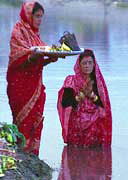 |
Nepal's
Religious Festivals |
|
 |
|
Nepal's
Religious Festivals |
| Janakpur:
Chhath festival |
 |
The
Chhath festival, celebrated by the people of this ancient capital of the
Mithila region, has been a cultural convergence of both the Maithili-speaking
people and the people migrated here from hill areas. Janakpur is believed
to be the capital of the legendary king Janak, the foster father of Sita,
who was married to Lord Ramchandra from Ayodhya in India.
People of the
Mithila region are of the opinion that the Chhath festival, also known
as Surya Pooja (worshipping the sun) has been described in the Rig Veda,
which isbelieved to be the oldest text available in the world. Chhath emerged
as a traditional festival after Draupadi, wife of the Pandavas, began worshipping
the sun during their one-year disguise inthe palace of king Birat.
|
People
believe that worshipping the sun would help cure the disease like leprosy
and bring about prosperity and longevity to their family members.
Local
people say that the festival has become more important after migrants from
the hills also adopted it as their own cultural asset. Women of the Mithila
region were busy in purchasing varieties of articles to offer to the sun
god. The Chhath festival is marked for four days.
Men and women prepare
special dishes made up of special rice and molasses and taste them after
an audience of the moon. They took a dip in Ganga Sagar and Dhanush Sagar,
the famous lakes of the area. During the four-day-festival, the devotees
worship the rising and setting sun.
| December:
Newars celebrate Saat Gaonley Jatra |
Hundreds
of villagers of Newar community living in seven villages of the Valley's
Southwest part celebrated the locally popular festival of Saat Gaonley
Jatra (festival of seven villages).The festival is celebrated at the premises
of Vishnu Devi temple, located in Tinthana village, on the way to Macchegaon.
Newar community in this part of the Valley celebrates this festival every
year according to the lunar calendar in the Dashami Tithi.
People from
seven villages - Satungul, Besigaon, Lahankot, Macchegaon, Taukhel, Naikap
and Teenthana converged at the Vishnu Devi temple to offers prayers. As
per the tradition, decorated chariots carrying the daughters of Goddess
Vishnu Devi were brought from Satungul, Macchegaon and Naikap villages
to the temple of Vishnu Devi on the midnight amid a chanting of drums and
other traditional instruments. And the chariot of Lord Bhairab was brought
from Besigaon and Lahankot villages to the temple.
A stone-script at the
temple shows that the temple was built in the 17th century. Beside these
seven villages, people in Kirtipur and Panga villages also celebrate this
festival, but in their own way. After the completion of the festival, the
chariots are kept at the temple vicinity and are taken back to their respective
villages only after a year. People celebrate the occasion in their respective
villages in their own way, which will continue for a week.
|



